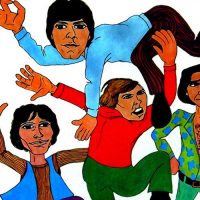When the Rascals broke up in 1972, guitarist Gene Cornish and drummer Dino Danelli wasted little time putting together another band.
For the unaware, the Rascals — who were initially called the Young Rascals — held sway as one of the greatest groups of the 1960s. Hailing from Long Island, New York, the band collected a cluster of shiny gold nuggets, including “Good Lovin’,” “I’ve Been Lonely Too Long,” “Groovin’,” “How Can I Be Sure,” “It’s a Beautiful Morning,” and “People Got to be Free,” that keenly mixed punchy rock arrangements with a smooth soul slant.
And so, shortly after the Rascals ceased to be, Gene Cornish and Dino Danelli joined forces with lead singer and bassist Billy Hocher, guitarist Eric Thorngren and keyboardist John Turi, resulting in the birth of Bulldog. The band’s self-titled debut album, produced by Gene and Dino, suggested they were off to a very promising start. Dominated by a loose and lively party vibe, Bulldog (Decca Records) stomped and swaggered with the raunchiest of the lot.
The album spawned a minor hit single with “No,” which reached No. 44 on the national charts. Guided by Billy’s whiskey-and-cigarettes growl, set somewhere between Leon Russell and Joe Cocker, the blues-based pop affair slinked and strutted with jaunty piano fills, cemented by a curtain of lilting Beatles-inspired harmonies. Further highlighted by snappy melodies, “No” certainly pushed all the right buttons to make a lasting impression.
Dripping with oil and grease, “I’m a Madman” and “Juicin’ With Lucy” groan to a crude-but-catchy tone of punishing drums, teeth-gnashing guitars and romping keyboards. A grinding version of Bobby Day’s “Rockin’ Robin” and a crushing cover of Chuck Berry’s “Too Much Monkey Business” acknowledge the band’s roots in an almost tongue-in-cheek manner. As a matter of fact, Bulldog pays quite a bit of homage to 1950s-styled rock and roll, but synthesizes these influences with a contemporary complexion comparable to acts like the Faces and Savoy Brown. A bar band mentality tends to drive much of the material on Bulldog, but such a comment is intended to be positive.
Smasher, Bulldog’s second album, appeared in 1974 on the Buddah label, and although credible moments were to be had, sales were weak and the band was then laid to rest. Come 1978, Gene Cornish and Dino Danelli connected with ex-Raspberries guitarist Wally Bryson and formed Fotomaker, and they experienced a brief burst of fame with their brand of slick power pop.
Hammering the point home with funky frills and boogie woogie rhythms, Bulldog steps in as a classic example of early-’70s blues-rocking soul. To be played loud for maximum effects, here’s an album worth checking out.
- ‘Magic’ Wasn’t One-Hit Wonder Pilot’s Only Quirky, Radio-Ready Treasure - April 18, 2025
- How ‘Hollies Sing Hollies’ Showed New Promise After Graham Nash’s Exit - November 14, 2024
- Barry Melton on Country Joe and the Fish, Woodstock – and That Chant - August 15, 2024



